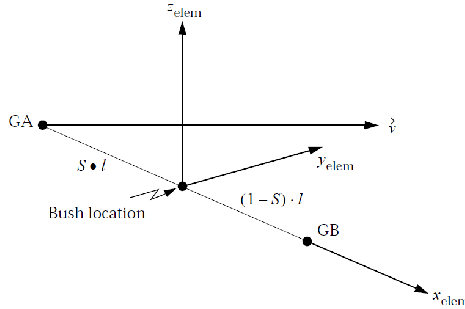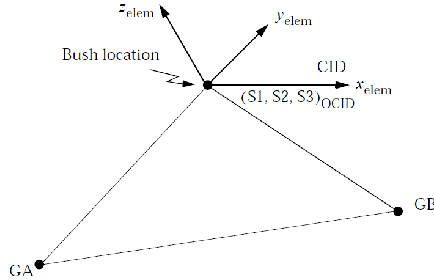- For the Results “Grid Point Forces, MPC Forces” and “Grid Point Forces, MPC Moments” The ElemId of each key is set to “NONE”. (These Results are pure nodal Results.)
- For the “Grid Point Forces, Internal Forces” and “Grid Point Forces, Internal Moments” Results, The ElementId associated to each vector corresponds to the MPC ID of the RBE element. This means that one must be careful when extracting these Results on Groups of MPCs.
The “STRAIN” Nastran output statement with “FIBER” option outputs the strain tensor at Z1 and Z2, but do not produce the curvature tensor.
- The signs of all the components are changed,
- The shear components of the tensor are divided by two.
This is done because FeResPost considers that positive curvature components correponds to positive strain components in upper face of the shell, and negative components in lower face of the shell. (See equation II.1.32 for the definition of curvature tensor components.)
The choice of considering bush forces and moments as beams is questionable, and we justify this choice as follows:
- When grids A and B are not coincident, the definition of CBUSH element axes can be done the same way as for CBEAM elements (Figure III.1.1.a). The vector points from grid A to grid B, and component of force vector is positive when the CBUSH element is in tension, and the analogy between CBUSH element and CBEAM elements perfect, and the tensorial character of CBUSH element forces and moments is obvious.
- It is no longer true when the CBUSH orientation is specified with a coordinate system as represented in Figure III.1.1.a. In such a case, component of force vector no longer can be interpreted as a tension in CBUSH element. It is only the force applied by grid B to grid A, and projected on CBUSH coordinate system axis.
CBUSH elements are often used in the modeling of connections. Whatever the type of coordinate system definition, is is always possible to obtain vectorial forces and moments by a contracted multiplication of the vectorial result with a unit vector:
This is generally the first operation performed when CBUSH loads are used for the sizing of connections. This also works when connection forces are extracted from CBEAM or CBAR elements.
- Nastran “CBUSH” elements for linear analyses produce vectorial or tensorial results in OEF and OES blocks.
- Nastran “CBUSH” elements for non-linear analyses produce vectorial or tensorial results in OES blocks. No results are produced in OEF blocks.
The element forces and moments are stored in “Beam Forces” and “Beam Moments” tensorial Results.
Note that FeResPost cannot determine the CFAST element coordinate system when grids A and B are coincident. This may cause problems when transformation of reference coordinate systems are required. (This is the case when gmsh outputs of results are requested.) Note also that Patran also seems to experience some difficulties to calculate CFAST element axes.
- Gap forces results are stored in “Gap Forces” tensorial Result. The value of the axial component is multiplied by “-1.0”, because it is a compression component.
- Gap deformations are stored in “Gap Deformations” tensorial Result. Here again the value of the axial component is multiplied by “-1.0”.
- “Gap Slips” is identical to “Gap Deformations” except that the axial component is set to “0.0”.
- This Result corresponds to the location of beam load recovery along the 1D element and varies between 0 and 1. It is scalar and has always a real format.
- Intermediate stations, differing from 0 or 1, are produced by CBEAM elements, or CBAR elements if associated to a CBARAO card.
- Up to 40 intermediate stations are supported by FeResPost. Beyond this value, Beam results are not read. This limit should be sufficient as Nastran Manuals recommend that no more than 6 interemdiate stations are defined by CBARAO bulk card, and as CBEAM element allow up to 9 intermediate stations.
- The node IDs to which intermediate station values are associated correspond to the “CbeamSt01” to “CbeamSt40” IDs defined in Table III.1.6.

